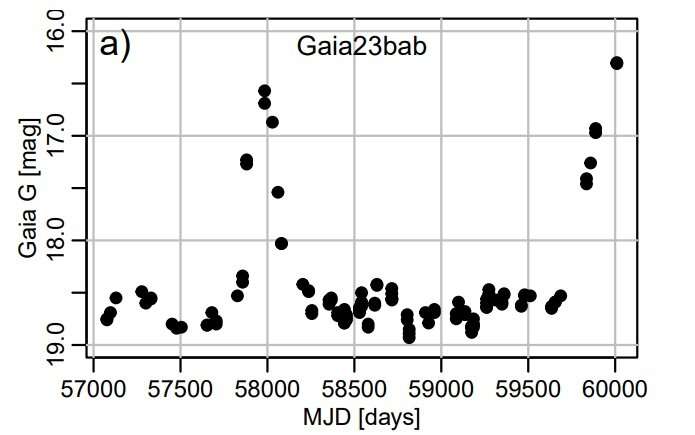March 24, 2023 report
This article has been reviewed according to Science X's editorial process and policies. Editors have highlighted the following attributes while ensuring the content's credibility:
fact-checked
preprint
trusted source
proofread
Repeating outbursts observed from young stellar object SPICY 97589

An international team of astronomers has detected repeating outbursts from a young stellar object (YSO) known as SPICY 97589 and analyzed their properties. Results of the study, presented in a paper published March 16 on the arXiv pre-print repository, shed more light on the nature of this YSO.
YSOs are stars in early stages of evolution, in particular, protostars and pre-main sequence stars. They are usually observed embedded in dense molecular clumps, environments containing plenty of molecular gas and interstellar dust.
Given that episodic accretion processes occur in YSOs, these objects may experience accretion-driven outbursts. Astronomers usually divide such events into EX Lup (also known as EXors) and FU Ori outbursts (or FUors). EXors are a few magnitudes in amplitude, and last from a few months to one or two years; FUors are more extreme and rare, can be up to 5 to 6 magnitudes in amplitude and last from decades to even centuries.
Recently, a science alert was issued from ESA's Gaia mission, indicating a brightening of SPICY 97589—a member of a small cluster of about 30 candidate YSOs, designated G38.3-0.9. A group of astronomers led by Michael A. Kuhn of the University of Hertfordshire, U.K., investigated this alert, which resulted in new insights into the nature of SPICY 97589.
"Here we discuss a Gaia alert (Hodgkin et al. 2021) for an ongoing outburst from a star in the Spitzer/IRAC Candidate YSO (SPICY) catalog (Kuhn et al. 2021). ... The Gaia alert, Gaia23bab (Hodgkin et al. 2023), was issued on March 6, 2023, and noted the brightening of SPICY 97589," the researchers wrote in the paper.
All in all, two bursts of SPICY 97589 were detected in the G-band light curve from Gaia. The first peaked in mid-2017 with a brightening of approximately 2.2 mag and a duration of about 13 months. During the second, ongoing outburst, it was found that the star has brightened from its quiescent magnitude of 18.7 mag to 16.3 mag, with most of the brightening happening since April 2022.
According to the study, the quiescent spectral energy distribution (SED) of SPICY 97589 suggests that it is an embedded pre-main-sequence (PMS) star with optical accretion emission and mid-infrared disk emission. Given that G38.3-0.9 appears to be partially embedded in a small infrared-dark star-forming cloud DOBASHI 1604, with a mass of around 1,800 solar masses, it further confirms the embedded PMS scenario for SPICY 97589.
The results indicate that the identified brightening events of SPICY 97589 are most likely accretion outbursts. The astronomers noted that the year-long duration of the 2017 brightening event and the repeated bursting behavior is typical of EX Lup-type objects. However, more spectroscopic observations of this star are required in order to confirm this hypothesis.
More information: Michael A. Kuhn et al, Repeating Outbursts from the Young Stellar Object Gaia23bab (= SPICY 97589), arXiv (2023). DOI: 10.48550/arxiv.2303.09409
Journal information: arXiv
© 2023 Science X Network





















